
IRFHM8337TRPbF
HEXFET
®
Power MOSFET
Base part number
Package Type
Standard Pack
Form
Quantity
IRFHM8337PbF
PQFN 3.3mm x 3.3mm
Tape and Reel
4000
IRFHM8337TRPbF
Orderable Part Number
V
DSS
30
V
R
DS(on)
max
(@ V
GS
= 10V)
12.4
(@ V
GS
= 4.5V)
17.9
Qg
(typical)
5.4
nC
I
D
(@T
C
= 25°C)
18 A
m
PQFN 3.3 x 3.3 mm
Features
Benefits
Low Thermal Resistance to PCB (< 5.0°C/W)
Enable better Thermal Dissipation
Low Profile (<1.05 mm)
results in Increased Power Density
Industry-Standard Pinout
Multi-Vendor Compatibility
Compatible with Existing Surface Mount Techniques
Easier Manufacturing
RoHS Compliant, Halogen-Free
Environmentally Friendlier
MSL1,Consumer Qualification
Increased Reliability
Notes through are on page 8
Absolute Maximum Ratings
Parameter Max.
Units
V
GS
Gate-to-Source Voltage
± 20
V
I
D
@ T
A
= 25°C
Continuous Drain Current, V
GS
@ 10V
12
A
I
D
@ T
A
= 70°C
Continuous Drain Current, V
GS
@ 10V
9.4
I
DM
Pulsed Drain Current 94
I
D
@ T
C(Bottom)
= 25°C
Continuous Drain Current, V
GS
@ 10V
35
I
D
@ T
C(Bottom)
= 100°C
Continuous Drain Current, V
GS
@ 10V
22
I
D
@ T
C
= 25°C
Continuous Drain Current, V
GS
@ 10V
(Source Bonding Technology Limited)
18
P
D
@T
A
= 25°C
Power Dissipation 2.8
W
P
D
@T
C(Bottom)
= 25°C
Power Dissipation 25
Linear Derating Factor 0.02
W/°C
T
J
Operating Junction and
-55 to + 150
°C
T
STG
Storage Temperature Range
Applications
System/load switch,
Charge or discharge switch for battery protection
1
2016-2-23
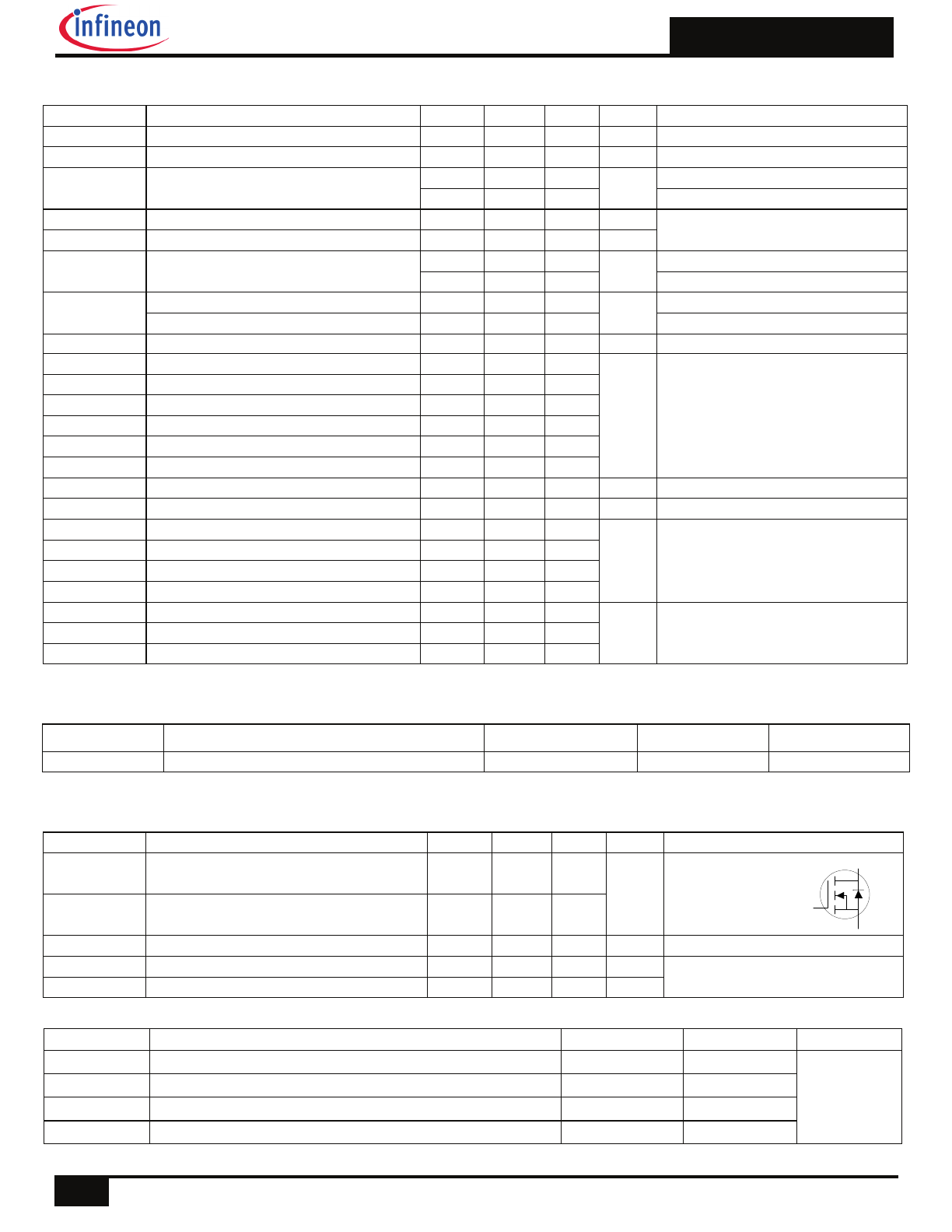
IRFHM8337TRPbF
2
2016-2-23
Static @ T
J
= 25°C (unless otherwise specified)
Parameter Min.
Typ.
Max.
Units
Conditions
BV
DSS
Drain-to-Source Breakdown Voltage
30
–––
–––
V
V
GS
= 0V, I
D
= 250µA
BV
DSS
/
T
J
Breakdown Voltage Temp. Coefficient
–––
0.02
–––
V/°C Reference to 25°C, I
D
= 1mA
R
DS(on)
Static Drain-to-Source On-Resistance
––– 9.4 12.4
m
V
GS
= 10V, I
D
= 12A
––– 14.5 17.9
V
GS
= 4.5V, I
D
=9.4A
V
GS(th)
Gate Threshold Voltage
1.35
1.8
2.35
V
V
DS
= V
GS
, I
D
= 25µA
V
GS(th)
Gate Threshold Voltage Coefficient
–––
-6.2
––– mV/°C
I
DSS
Drain-to-Source Leakage Current
––– ––– 1.0
µA
V
DS
= 24V, V
GS
= 0V
––– ––– 150
V
DS
= 24V, V
GS
= 0V,T
J
= 125°C
I
GSS
Gate-to-Source Forward Leakage –––
–––
100
µA
V
GS
= 20V
Gate-to-Source Reverse Leakage
–––
–––
-100
V
GS
=-20 V
gfs Forward
Transconductance
17
–––
–––
S
V
DS
= 15V, I
D
= 9.4A
Q
g
Total Gate Charge
–––
5.4
8.1
Q
gs1
Pre-Vth Gate-to-Source Charge
–––
1.1
–––
V
DS
= 15V
Q
gs2
Post-Vth Gate-to-Source Charge
–––
0.7
–––
nC V
GS
= 4.5V
Q
gd
Gate-to-Drain Charge
–––
2.2
–––
I
D
= 9.4A
Q
godr
Gate Charge Overdrive
–––
1.5
–––
Q
sw
Switch Charge (Q
gs2
+ Q
gd
) –––
2.9
–––
Q
oss
Output Charge
–––
3.8
–––
nC V
DS
= 16V, V
GS
= 0V
R
G
Gate Resistance
–––
2.0
–––
t
d(on)
Turn-On Delay Time
–––
9.0
–––
V
DD
= 15V, V
GS
= 4.5V
t
r
Rise Time
–––
11
–––
ns I
D
= 9.4A
t
d(off)
Turn-Off Delay Time
–––
9.9
–––
R
G
= 1.3
t
f
Fall Time
–––
5.6
–––
C
iss
Input Capacitance
–––
755
–––
V
GS
= 0V
C
oss
Output Capacitance
–––
171
–––
pF V
DS
= 15V
C
rss
Reverse Transfer Capacitance
–––
83
–––
ƒ = 1.0MHz
Parameter Typ.
Max.
Units
R
JC
(Bottom) Junction-to-Case –––
5.0
R
JC
(Top)
Junction-to-Case –––
50
°C/W
R
JA
Junction-to-Ambient –––
45
R
JA
(<10s)
Junction-to-Ambient –––
31
Thermal Resistance
Diode Characteristics
Parameter
Min.
Typ.
Max. Units
Conditions
I
S
Continuous Source Current
–––
–––
18 MOSFET
symbol
(Body Diode)
showing the
I
SM
Pulsed Source Current
–––
–––
94
integral reverse
(Body Diode)
p-n junction diode.
V
SD
Diode Forward Voltage
–––
–––
1.0
V
T
J
= 25°C, I
S
= 9.4A, V
GS
= 0V
t
rr
Reverse Recovery Time
–––
20
30
ns
T
J
= 25°C, I
F
= 9.4A, V
DD
= 15V
Q
rr
Reverse Recovery Charge
–––
27
41
nC di/dt = 200A/µs
A
Avalanche Characteristics
Parameter Typ.
Max.
Units
E
AS
Single Pulse Avalanche Energy –––
13 mJ
D
S
G

IRFHM8337TRPbF
3
2016-2-23
Fig 1. Typical Output Characteristics
Fig 4. Normalized On-Resistance vs. Temperature
Fig 5. Typical Capacitance vs. Drain-to-Source Voltage
Fig 6. Typical Gate Charge vs. Gate-to-Source Voltage
Fig 3. Typical Transfer Characteristics
Fig 2. Typical Output Characteristics
0.1
1
10
100
VDS, Drain-to-Source Voltage (V)
0.1
1
10
100
1000
I D
,
D
ra
in
-t
o
-S
ou
rc
e
C
u
rr
en
t
(A
)
VGS
TOP 10V
5.0V
4.5V
3.5V
3.3V
3.0V
2.9V
BOTTOM
2.7V
60µs PULSE WIDTH
Tj = 25°C
2.7V
0.1
1
10
100
VDS, Drain-to-Source Voltage (V)
1
10
100
1000
I D
, D
ra
in
-t
o-
S
o
ur
ce
C
u
rr
en
t
(A
)
2.7V
60µs PULSE WIDTH
Tj = 150°C
VGS
TOP 10V
5.0V
4.5V
3.5V
3.3V
3.0V
2.9V
BOTTOM
2.7V
1
2
3
4
5
6
VGS, Gate-to-Source Voltage (V)
0.1
1
10
100
I D
, D
ra
in
-t
o-
S
ou
rc
e
C
ur
re
nt
(A
)
TJ = 25°C
TJ = 150°C
VDS = 15V
60µs PULSE WIDTH
-60 -40 -20 0 20 40 60 80 100 120 140 160
TJ , Junction Temperature (°C)
0.6
0.8
1.0
1.2
1.4
1.6
1.8
R
D
S
(o
n)
,
D
ra
in
-t
o-
S
ou
rc
e
O
n
R
es
is
ta
nc
e
(
N
or
m
al
iz
ed
)
ID = 12A
VGS = 10V
1
10
100
VDS, Drain-to-Source Voltage (V)
10
100
1000
10000
C
, C
ap
ac
ita
nc
e
(p
F
)
VGS = 0V, f = 1 MHZ
Ciss = Cgs + Cgd, C ds SHORTED
Crss = Cgd
Coss = Cds + Cgd
Coss
Crss
Ciss
0
2
4
6
8
10
12
14
16
QG, Total Gate Charge (nC)
0.0
2.0
4.0
6.0
8.0
10.0
12.0
14.0
V
G
S
, G
at
e-
to
-S
ou
rc
e
V
ol
ta
ge
(
V
)
VDS= 24V
VDS= 15V
ID= 9.4A
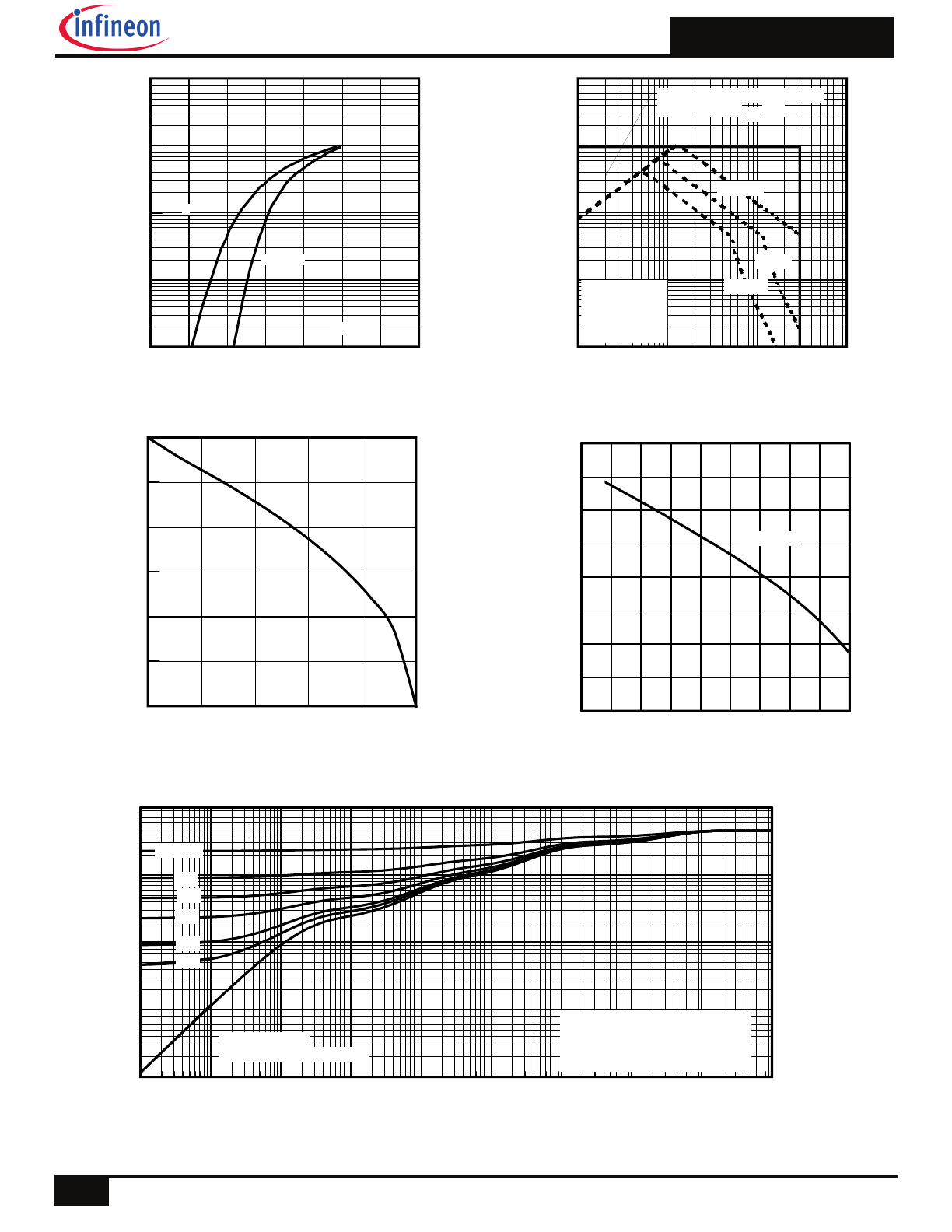
IRFHM8337TRPbF
4
2016-2-23
Fig 8. Maximum Safe Operating Area
Fig 7. Typical Source-Drain Diode Forward Voltage
25
50
75
100
125
150
TA , Ambient Temperature (°C)
0
2
4
6
8
10
12
I D
,
D
ra
in
C
ur
re
nt
(
A
)
Fig 9. Maximum Drain Current vs. Ambient Temperature
1E-006
1E-005
0.0001
0.001
0.01
0.1
1
10
100
1000
t1 , Rectangular Pulse Duration (sec)
0.01
0.1
1
10
100
T
he
rma
l R
es
po
ns
e
(
Z
th
JA
)
°
C
/W
0.20
0.10
D = 0.50
0.02
0.01
0.05
SINGLE PULSE
( THERMAL RESPONSE )
Notes:
1. Duty Factor D = t1/t2
2. Peak Tj = P dm x Zthja + TA
-75 -50 -25
0
25
50
75 100 125 150
TJ , Temperature ( °C )
0.5
1.0
1.5
2.0
2.5
V
G
S
(t
h)
, G
at
e
T
hr
es
ho
ld
V
ol
ta
ge
(
V
)
ID = 25µA
Fig 10.
Threshold Voltage Vs. Temperature
Fig 11. Maximum Effective Transient Thermal Impedance, Junction-to-Case
0.2
0.4
0.6
0.8
1
1.2
1.4
1.6
VSD, Source-to-Drain Voltage (V)
0.1
1
10
100
1000
I S
D
, R
ev
er
se
D
ra
in
C
ur
re
nt
(
A
)
TJ = 25°C
TJ = 150°C
VGS = 0V
0
1
10
100
VDS, Drain-to-Source Voltage (V)
0.1
1
10
100
1000
I D
,
D
ra
in
-t
o-
S
ou
rc
e
C
ur
re
nt
(
A
)
OPERATION IN THIS AREA
LIMITED BY R DS(on)
TA = 25°C
Tj = 150°C
Single Pulse
100µsec
1msec
10msec

IRFHM8337TRPbF
5
2016-2-23
25
50
75
100
125
150
Starting TJ , Junction Temperature (°C)
0
10
20
30
40
50
60
E
A
S
,
S
in
gl
e
P
ul
se
A
va
la
nc
he
E
ne
rg
y
(m
J)
ID
TOP 2.95A
3.63A
BOTTOM 9.40A
Fig 13. Maximum Avalanche Energy vs. Drain Current
Fig 14. Single avalanche event: pulse current vs. pulse width
2
4
6
8
10
12
14
16
18
20
VGS, Gate -to -Source Voltage (V)
5
10
15
20
25
30
35
R
D
S
(o
n)
,
D
ra
in
-t
o
-S
ou
rc
e
O
n
R
es
is
ta
nc
e
(m
)
ID = 12A
TJ = 25°C
TJ = 125°C
Fig 12. On– Resistance vs. Gate Voltage
1.0E-05
1.0E-04
1.0E-03
1.0E-02
1.0E-01
tav (sec)
0.01
0.1
1
10
100
A
va
la
nc
he
C
ur
re
nt
(
A
)
Allowed avalanche Current vs avalanche
pulsewidth, tav, assuming
j = 25°C and
Tstart = 125°C.
Allowed avalanche Current vs avalanche
pulsewidth, tav, assuming
Tj = 125°C and
Tstart =25°C (Single Pulse)
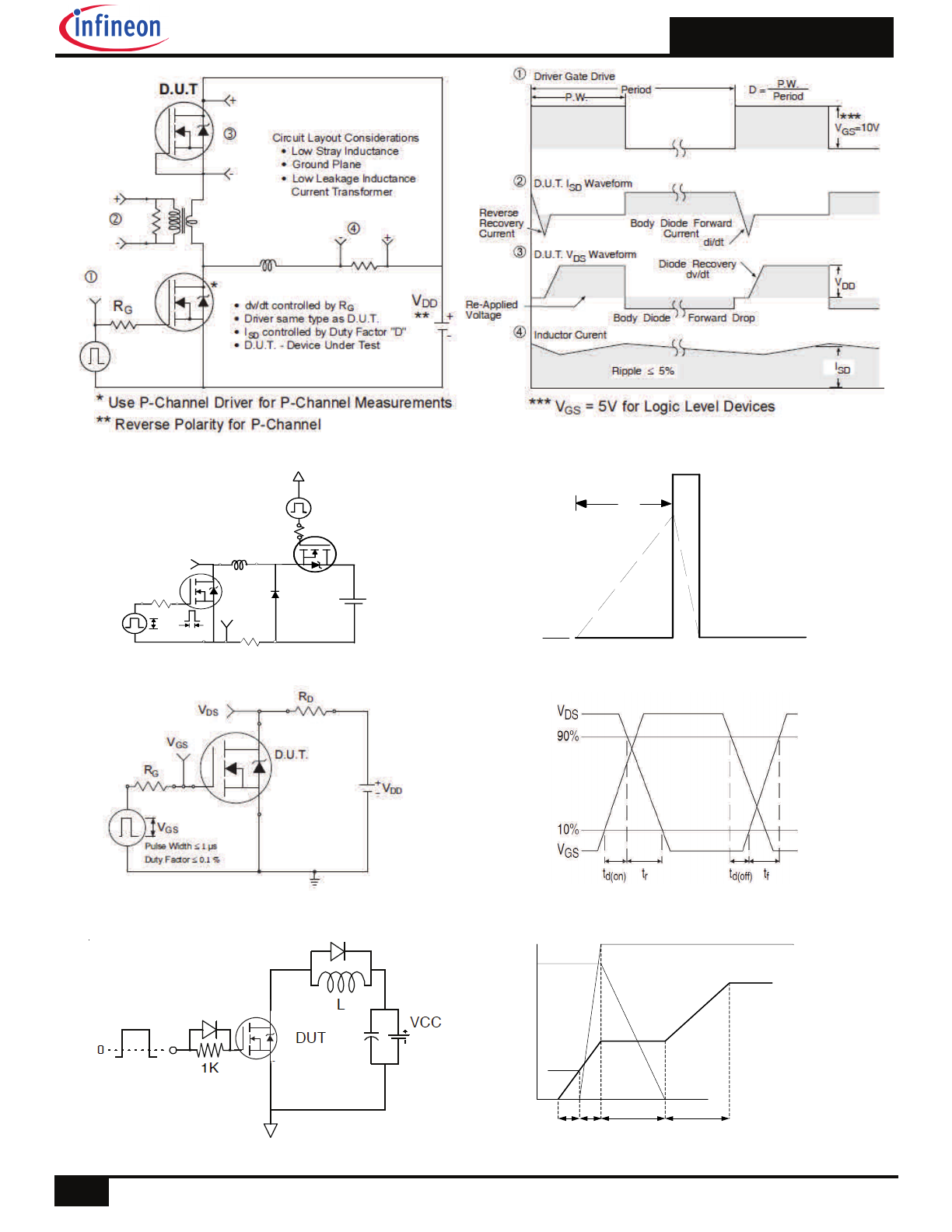
IRFHM8337TRPbF
6
2016-2-23
Fig 15. Peak Diode Recovery dv/dt Test Circuit for N-Channel HEXFET
®
Power MOSFETs
Fig 18. Gate Charge Test Circuit
Vds
Vgs
Id
Vgs(th)
Qgs1 Qgs2
Qgd
Qgodr
Fig 19. Gate Charge Waveform
Fig 17a. Switching Time Test Circuit
Fig 17b. Switching Time Waveforms
Fig 16a. Unclamped Inductive Test Circuit
R G
I
AS
0.01
tp
D.U.T
L
VDS
+
- VDD
DRIVER
A
15V
20V
tp
V
(BR)DSS
I
AS
Fig 16b. Unclamped Inductive Waveforms
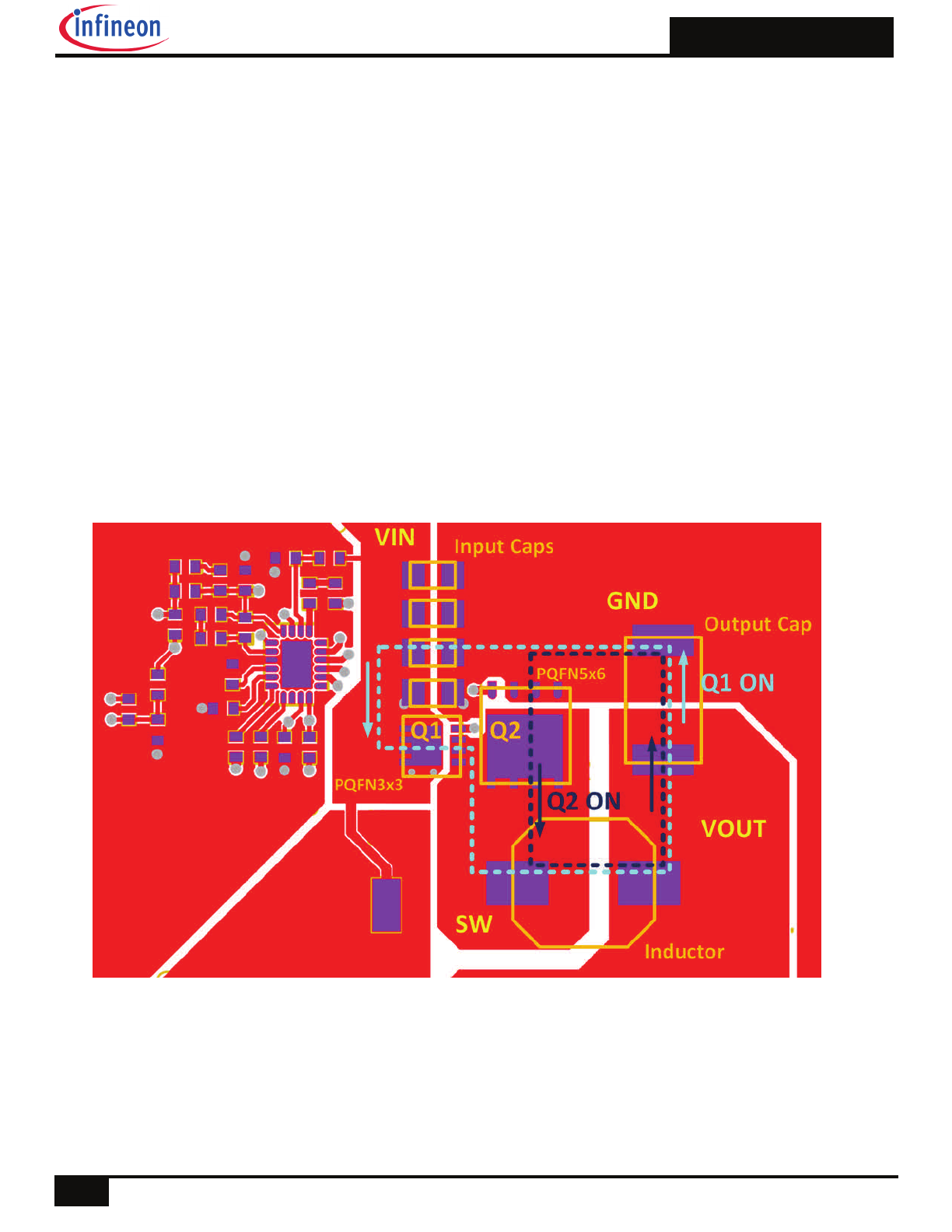
IRFHM8337TRPbF
7
2016-2-23
Placement and Layout Guidelines
The typical application topology for this product is the synchronous buck converter. These converters operate at high
frequencies (typically around 400 kHz). During turn-on and turn-off switching cycles, the high di/dt currents circulating in
the parasitic elements of the circuit induce high voltage ringing which may exceed the device rating and lead to undesir-
able effects. One of the major contributors to the increase in parasitics is the PCB power circuit inductance.
This section introduces a simple guideline that mitigates the effect of these parasitics on the performance of the circuit
and provides reliable operation of the devices.
To reduce high frequency switching noise and the effects of Electromagnetic Interference (EMI) when the control
MOSFET (Q1) is turned on, the layout shown in Figure 19 is recommended. The input bypass capacitors, control
MOSFET and output capacitors are placed in a tight loop to minimize parasitic inductance which in turn lowers the am-
plitude of the switch node ringing, and minimizes exposure of the MOSFETs to repetitive avalanche conditions.
When the synchronous MOSFET (Q2) is turned on, high average DC current flows through the path indicated in Figure
19. Therefore, the Q2 turn-on path should be laid out with a tight loop and wide traces at both ends of the inductor to
minimize loop resistance.

IRFHM8337TRPbF
8
2016-2-23
For more information on board mounting, including footprint and stencil recommendation, please refer to application note
AN-1136:
http://www.irf.com/technical-info/appnotes/an-1136.pdf
For more information on package inspection techniques, please refer to application note AN-1154:
http://www.irf.com/technical-info/appnotes/an-1154.pdf
PQFN 3.3 x 3.3 Outline “C” Package Details
PQFN 3.3 x 3.3 Outline “G” Package Details
5
8
7
6
#1
3
2
4
#1
2
3
4
8
7
6
5
5
8
7
6
1
3
2
4
1
2
3
4
8
7
6
5
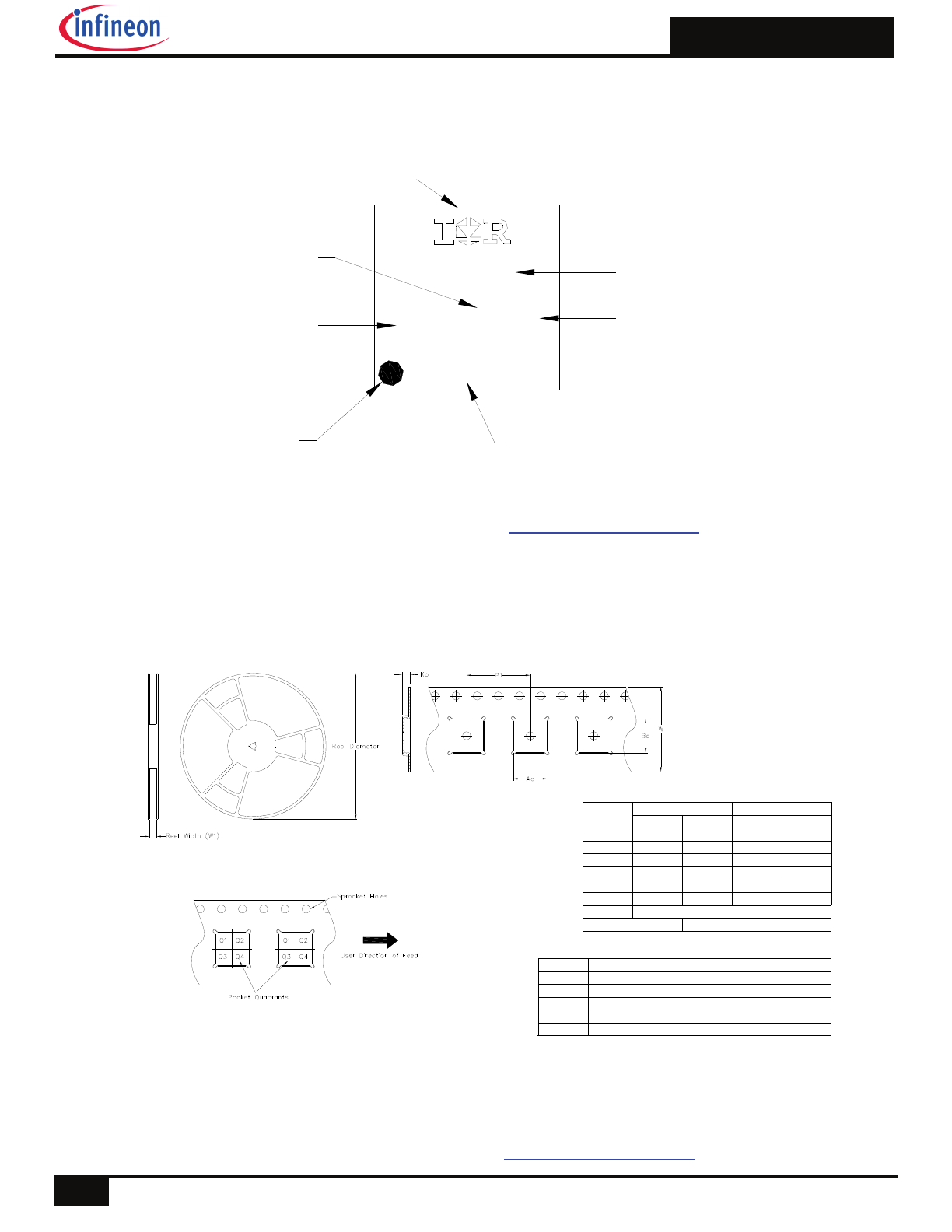
IRFHM8337TRPbF
9
2016-2-23
Note: For the most current drawing please refer to IR website at
http://www.irf.com/package/
PQFN 3.3 x 3.3 Tape and Reel
Bo
W
P1
Ao
Ko
CODE
TAPE DIMENSIONS
REEL DIMENSIONS
QUADRANT ASSIGNMENTS FOR PIN 1 ORIENTATION IN TAPE
Dimension design to accommodate the component width
Dimension design to accommodate the component lenght
Dimension design to accommodate the component thickness
Pitch between successive cavity centers
Overall width of the carrier tape
Bo
W
P1
Ao
Ko
DIMENSION (MM)
CODE
MIN
MAX
DIMENSION (INCH)
MIN
MAX
3.50
3.70
.138
.146
1.10
1.30
7.90
8.10
.043
.051
11.80
12.20
.311
.319
12.30
12.50
.465
.480
.484
.492
3.50
3.70
.138
.146
DESCRIPTION
W1
Qty
4000
Reel Diameter
13 Inches
Note: For the most current drawing please refer to IR website at
http://www.irf.com/package/
PQFN 3.3 x 3.3 Part Marking
XXXX
?YWW?
XXXXX
INTERNATIONAL
RECTIFIER LOGO
PART NUMBER
MARKING CODE
(Per Marking Spec)
ASSEMBLY
SITE CODE
(Per SCOP 200-002)
DATE CODE
LOT CODE
(Eng Mode - Min last 4 digits of EATI#)
(Prod Mode - 4 digits of SPN code)
PIN 1
IDENTIFIER

IRFHM8337TRPbF
10
2016-2-23
†
Qualification standards can be found at International Rectifier’s web site:
http://www.irf.com/product-info/reliability/
†† Higher qualification ratings may be available should the user have such requirements.
Please contact your International Rectifier sales representative for further information:
http://www.irf.com/whoto-call/salesrep/
††† Applicable version of JEDEC standard at the time of product release.
Qualification Information
†
Qualification Level
Moisture Sensitivity Level
PQFN 3.3mm x 3.3mm
MSL1
(per JEDEC J-STD-020D
†††
)
RoHS Compliant
Yes
Consumer
††
(per JEDEC JESD47F guidelines)
Notes:
Repetitive rating; pulse width limited by max. junction temperature.
Starting T
J
= 25°C, L = 0.297mH, R
G
= 50
, I
AS
= 9.4A.
Pulse width
400µs; duty cycle 2%.
R
is measured at TJ of approximately 90°C.
When mounted on 1 inch square PCB (FR-4). Please refer to AN-994 for more details:
http://www.irf.com/technical-info/appnotes/an-994.pdf
Calculated continuous current based on maximum allowable junction temperature.
Current limited to 18A by source bonding technology.
Pulse drain current is limited to 72A by source bonding technology.

IRFHM8337TRPbF
HEXFET
®
Power MOSFET
Base part number
Package Type
Standard Pack
Form
Quantity
IRFHM8337PbF
PQFN 3.3mm x 3.3mm
Tape and Reel
4000
IRFHM8337TRPbF
Orderable Part Number
V
DSS
30
V
R
DS(on)
max
(@ V
GS
= 10V)
12.4
(@ V
GS
= 4.5V)
17.9
Qg
(typical)
5.4
nC
I
D
(@T
C
= 25°C)
18 A
m
PQFN 3.3 x 3.3 mm
Features
Benefits
Low Thermal Resistance to PCB (< 5.0°C/W)
Enable better Thermal Dissipation
Low Profile (<1.05 mm)
results in Increased Power Density
Industry-Standard Pinout
Multi-Vendor Compatibility
Compatible with Existing Surface Mount Techniques
Easier Manufacturing
RoHS Compliant, Halogen-Free
Environmentally Friendlier
MSL1,Consumer Qualification
Increased Reliability
Notes through are on page 8
Absolute Maximum Ratings
Parameter Max.
Units
V
GS
Gate-to-Source Voltage
± 20
V
I
D
@ T
A
= 25°C
Continuous Drain Current, V
GS
@ 10V
12
A
I
D
@ T
A
= 70°C
Continuous Drain Current, V
GS
@ 10V
9.4
I
DM
Pulsed Drain Current 94
I
D
@ T
C(Bottom)
= 25°C
Continuous Drain Current, V
GS
@ 10V
35
I
D
@ T
C(Bottom)
= 100°C
Continuous Drain Current, V
GS
@ 10V
22
I
D
@ T
C
= 25°C
Continuous Drain Current, V
GS
@ 10V
(Source Bonding Technology Limited)
18
P
D
@T
A
= 25°C
Power Dissipation 2.8
W
P
D
@T
C(Bottom)
= 25°C
Power Dissipation 25
Linear Derating Factor 0.02
W/°C
T
J
Operating Junction and
-55 to + 150
°C
T
STG
Storage Temperature Range
Applications
System/load switch,
Charge or discharge switch for battery protection
1
2016-2-23

IRFHM8337TRPbF
2
2016-2-23
Static @ T
J
= 25°C (unless otherwise specified)
Parameter Min.
Typ.
Max.
Units
Conditions
BV
DSS
Drain-to-Source Breakdown Voltage
30
–––
–––
V
V
GS
= 0V, I
D
= 250µA
BV
DSS
/
T
J
Breakdown Voltage Temp. Coefficient
–––
0.02
–––
V/°C Reference to 25°C, I
D
= 1mA
R
DS(on)
Static Drain-to-Source On-Resistance
––– 9.4 12.4
m
V
GS
= 10V, I
D
= 12A
––– 14.5 17.9
V
GS
= 4.5V, I
D
=9.4A
V
GS(th)
Gate Threshold Voltage
1.35
1.8
2.35
V
V
DS
= V
GS
, I
D
= 25µA
V
GS(th)
Gate Threshold Voltage Coefficient
–––
-6.2
––– mV/°C
I
DSS
Drain-to-Source Leakage Current
––– ––– 1.0
µA
V
DS
= 24V, V
GS
= 0V
––– ––– 150
V
DS
= 24V, V
GS
= 0V,T
J
= 125°C
I
GSS
Gate-to-Source Forward Leakage –––
–––
100
µA
V
GS
= 20V
Gate-to-Source Reverse Leakage
–––
–––
-100
V
GS
=-20 V
gfs Forward
Transconductance
17
–––
–––
S
V
DS
= 15V, I
D
= 9.4A
Q
g
Total Gate Charge
–––
5.4
8.1
Q
gs1
Pre-Vth Gate-to-Source Charge
–––
1.1
–––
V
DS
= 15V
Q
gs2
Post-Vth Gate-to-Source Charge
–––
0.7
–––
nC V
GS
= 4.5V
Q
gd
Gate-to-Drain Charge
–––
2.2
–––
I
D
= 9.4A
Q
godr
Gate Charge Overdrive
–––
1.5
–––
Q
sw
Switch Charge (Q
gs2
+ Q
gd
) –––
2.9
–––
Q
oss
Output Charge
–––
3.8
–––
nC V
DS
= 16V, V
GS
= 0V
R
G
Gate Resistance
–––
2.0
–––
t
d(on)
Turn-On Delay Time
–––
9.0
–––
V
DD
= 15V, V
GS
= 4.5V
t
r
Rise Time
–––
11
–––
ns I
D
= 9.4A
t
d(off)
Turn-Off Delay Time
–––
9.9
–––
R
G
= 1.3
t
f
Fall Time
–––
5.6
–––
C
iss
Input Capacitance
–––
755
–––
V
GS
= 0V
C
oss
Output Capacitance
–––
171
–––
pF V
DS
= 15V
C
rss
Reverse Transfer Capacitance
–––
83
–––
ƒ = 1.0MHz
Parameter Typ.
Max.
Units
R
JC
(Bottom) Junction-to-Case –––
5.0
R
JC
(Top)
Junction-to-Case –––
50
°C/W
R
JA
Junction-to-Ambient –––
45
R
JA
(<10s)
Junction-to-Ambient –––
31
Thermal Resistance
Diode Characteristics
Parameter
Min.
Typ.
Max. Units
Conditions
I
S
Continuous Source Current
–––
–––
18 MOSFET
symbol
(Body Diode)
showing the
I
SM
Pulsed Source Current
–––
–––
94
integral reverse
(Body Diode)
p-n junction diode.
V
SD
Diode Forward Voltage
–––
–––
1.0
V
T
J
= 25°C, I
S
= 9.4A, V
GS
= 0V
t
rr
Reverse Recovery Time
–––
20
30
ns
T
J
= 25°C, I
F
= 9.4A, V
DD
= 15V
Q
rr
Reverse Recovery Charge
–––
27
41
nC di/dt = 200A/µs
A
Avalanche Characteristics
Parameter Typ.
Max.
Units
E
AS
Single Pulse Avalanche Energy –––
13 mJ
D
S
G

IRFHM8337TRPbF
3
2016-2-23
Fig 1. Typical Output Characteristics
Fig 4. Normalized On-Resistance vs. Temperature
Fig 5. Typical Capacitance vs. Drain-to-Source Voltage
Fig 6. Typical Gate Charge vs. Gate-to-Source Voltage
Fig 3. Typical Transfer Characteristics
Fig 2. Typical Output Characteristics
0.1
1
10
100
VDS, Drain-to-Source Voltage (V)
0.1
1
10
100
1000
I D
,
D
ra
in
-t
o
-S
ou
rc
e
C
u
rr
en
t
(A
)
VGS
TOP 10V
5.0V
4.5V
3.5V
3.3V
3.0V
2.9V
BOTTOM
2.7V
60µs PULSE WIDTH
Tj = 25°C
2.7V
0.1
1
10
100
VDS, Drain-to-Source Voltage (V)
1
10
100
1000
I D
, D
ra
in
-t
o-
S
o
ur
ce
C
u
rr
en
t
(A
)
2.7V
60µs PULSE WIDTH
Tj = 150°C
VGS
TOP 10V
5.0V
4.5V
3.5V
3.3V
3.0V
2.9V
BOTTOM
2.7V
1
2
3
4
5
6
VGS, Gate-to-Source Voltage (V)
0.1
1
10
100
I D
, D
ra
in
-t
o-
S
ou
rc
e
C
ur
re
nt
(A
)
TJ = 25°C
TJ = 150°C
VDS = 15V
60µs PULSE WIDTH
-60 -40 -20 0 20 40 60 80 100 120 140 160
TJ , Junction Temperature (°C)
0.6
0.8
1.0
1.2
1.4
1.6
1.8
R
D
S
(o
n)
,
D
ra
in
-t
o-
S
ou
rc
e
O
n
R
es
is
ta
nc
e
(
N
or
m
al
iz
ed
)
ID = 12A
VGS = 10V
1
10
100
VDS, Drain-to-Source Voltage (V)
10
100
1000
10000
C
, C
ap
ac
ita
nc
e
(p
F
)
VGS = 0V, f = 1 MHZ
Ciss = Cgs + Cgd, C ds SHORTED
Crss = Cgd
Coss = Cds + Cgd
Coss
Crss
Ciss
0
2
4
6
8
10
12
14
16
QG, Total Gate Charge (nC)
0.0
2.0
4.0
6.0
8.0
10.0
12.0
14.0
V
G
S
, G
at
e-
to
-S
ou
rc
e
V
ol
ta
ge
(
V
)
VDS= 24V
VDS= 15V
ID= 9.4A

IRFHM8337TRPbF
4
2016-2-23
Fig 8. Maximum Safe Operating Area
Fig 7. Typical Source-Drain Diode Forward Voltage
25
50
75
100
125
150
TA , Ambient Temperature (°C)
0
2
4
6
8
10
12
I D
,
D
ra
in
C
ur
re
nt
(
A
)
Fig 9. Maximum Drain Current vs. Ambient Temperature
1E-006
1E-005
0.0001
0.001
0.01
0.1
1
10
100
1000
t1 , Rectangular Pulse Duration (sec)
0.01
0.1
1
10
100
T
he
rma
l R
es
po
ns
e
(
Z
th
JA
)
°
C
/W
0.20
0.10
D = 0.50
0.02
0.01
0.05
SINGLE PULSE
( THERMAL RESPONSE )
Notes:
1. Duty Factor D = t1/t2
2. Peak Tj = P dm x Zthja + TA
-75 -50 -25
0
25
50
75 100 125 150
TJ , Temperature ( °C )
0.5
1.0
1.5
2.0
2.5
V
G
S
(t
h)
, G
at
e
T
hr
es
ho
ld
V
ol
ta
ge
(
V
)
ID = 25µA
Fig 10.
Threshold Voltage Vs. Temperature
Fig 11. Maximum Effective Transient Thermal Impedance, Junction-to-Case
0.2
0.4
0.6
0.8
1
1.2
1.4
1.6
VSD, Source-to-Drain Voltage (V)
0.1
1
10
100
1000
I S
D
, R
ev
er
se
D
ra
in
C
ur
re
nt
(
A
)
TJ = 25°C
TJ = 150°C
VGS = 0V
0
1
10
100
VDS, Drain-to-Source Voltage (V)
0.1
1
10
100
1000
I D
,
D
ra
in
-t
o-
S
ou
rc
e
C
ur
re
nt
(
A
)
OPERATION IN THIS AREA
LIMITED BY R DS(on)
TA = 25°C
Tj = 150°C
Single Pulse
100µsec
1msec
10msec

IRFHM8337TRPbF
5
2016-2-23
25
50
75
100
125
150
Starting TJ , Junction Temperature (°C)
0
10
20
30
40
50
60
E
A
S
,
S
in
gl
e
P
ul
se
A
va
la
nc
he
E
ne
rg
y
(m
J)
ID
TOP 2.95A
3.63A
BOTTOM 9.40A
Fig 13. Maximum Avalanche Energy vs. Drain Current
Fig 14. Single avalanche event: pulse current vs. pulse width
2
4
6
8
10
12
14
16
18
20
VGS, Gate -to -Source Voltage (V)
5
10
15
20
25
30
35
R
D
S
(o
n)
,
D
ra
in
-t
o
-S
ou
rc
e
O
n
R
es
is
ta
nc
e
(m
)
ID = 12A
TJ = 25°C
TJ = 125°C
Fig 12. On– Resistance vs. Gate Voltage
1.0E-05
1.0E-04
1.0E-03
1.0E-02
1.0E-01
tav (sec)
0.01
0.1
1
10
100
A
va
la
nc
he
C
ur
re
nt
(
A
)
Allowed avalanche Current vs avalanche
pulsewidth, tav, assuming
j = 25°C and
Tstart = 125°C.
Allowed avalanche Current vs avalanche
pulsewidth, tav, assuming
Tj = 125°C and
Tstart =25°C (Single Pulse)

IRFHM8337TRPbF
6
2016-2-23
Fig 15. Peak Diode Recovery dv/dt Test Circuit for N-Channel HEXFET
®
Power MOSFETs
Fig 18. Gate Charge Test Circuit
Vds
Vgs
Id
Vgs(th)
Qgs1 Qgs2
Qgd
Qgodr
Fig 19. Gate Charge Waveform
Fig 17a. Switching Time Test Circuit
Fig 17b. Switching Time Waveforms
Fig 16a. Unclamped Inductive Test Circuit
R G
I
AS
0.01
tp
D.U.T
L
VDS
+
- VDD
DRIVER
A
15V
20V
tp
V
(BR)DSS
I
AS
Fig 16b. Unclamped Inductive Waveforms

IRFHM8337TRPbF
7
2016-2-23
Placement and Layout Guidelines
The typical application topology for this product is the synchronous buck converter. These converters operate at high
frequencies (typically around 400 kHz). During turn-on and turn-off switching cycles, the high di/dt currents circulating in
the parasitic elements of the circuit induce high voltage ringing which may exceed the device rating and lead to undesir-
able effects. One of the major contributors to the increase in parasitics is the PCB power circuit inductance.
This section introduces a simple guideline that mitigates the effect of these parasitics on the performance of the circuit
and provides reliable operation of the devices.
To reduce high frequency switching noise and the effects of Electromagnetic Interference (EMI) when the control
MOSFET (Q1) is turned on, the layout shown in Figure 19 is recommended. The input bypass capacitors, control
MOSFET and output capacitors are placed in a tight loop to minimize parasitic inductance which in turn lowers the am-
plitude of the switch node ringing, and minimizes exposure of the MOSFETs to repetitive avalanche conditions.
When the synchronous MOSFET (Q2) is turned on, high average DC current flows through the path indicated in Figure
19. Therefore, the Q2 turn-on path should be laid out with a tight loop and wide traces at both ends of the inductor to
minimize loop resistance.

IRFHM8337TRPbF
8
2016-2-23
For more information on board mounting, including footprint and stencil recommendation, please refer to application note
AN-1136:
http://www.irf.com/technical-info/appnotes/an-1136.pdf
For more information on package inspection techniques, please refer to application note AN-1154:
http://www.irf.com/technical-info/appnotes/an-1154.pdf
PQFN 3.3 x 3.3 Outline “C” Package Details
PQFN 3.3 x 3.3 Outline “G” Package Details
5
8
7
6
#1
3
2
4
#1
2
3
4
8
7
6
5
5
8
7
6
1
3
2
4
1
2
3
4
8
7
6
5

IRFHM8337TRPbF
9
2016-2-23
Note: For the most current drawing please refer to IR website at
http://www.irf.com/package/
PQFN 3.3 x 3.3 Tape and Reel
Bo
W
P1
Ao
Ko
CODE
TAPE DIMENSIONS
REEL DIMENSIONS
QUADRANT ASSIGNMENTS FOR PIN 1 ORIENTATION IN TAPE
Dimension design to accommodate the component width
Dimension design to accommodate the component lenght
Dimension design to accommodate the component thickness
Pitch between successive cavity centers
Overall width of the carrier tape
Bo
W
P1
Ao
Ko
DIMENSION (MM)
CODE
MIN
MAX
DIMENSION (INCH)
MIN
MAX
3.50
3.70
.138
.146
1.10
1.30
7.90
8.10
.043
.051
11.80
12.20
.311
.319
12.30
12.50
.465
.480
.484
.492
3.50
3.70
.138
.146
DESCRIPTION
W1
Qty
4000
Reel Diameter
13 Inches
Note: For the most current drawing please refer to IR website at
http://www.irf.com/package/
PQFN 3.3 x 3.3 Part Marking
XXXX
?YWW?
XXXXX
INTERNATIONAL
RECTIFIER LOGO
PART NUMBER
MARKING CODE
(Per Marking Spec)
ASSEMBLY
SITE CODE
(Per SCOP 200-002)
DATE CODE
LOT CODE
(Eng Mode - Min last 4 digits of EATI#)
(Prod Mode - 4 digits of SPN code)
PIN 1
IDENTIFIER

IRFHM8337TRPbF
10
2016-2-23
†
Qualification standards can be found at International Rectifier’s web site:
http://www.irf.com/product-info/reliability/
†† Higher qualification ratings may be available should the user have such requirements.
Please contact your International Rectifier sales representative for further information:
http://www.irf.com/whoto-call/salesrep/
††† Applicable version of JEDEC standard at the time of product release.
Qualification Information
†
Qualification Level
Moisture Sensitivity Level
PQFN 3.3mm x 3.3mm
MSL1
(per JEDEC J-STD-020D
†††
)
RoHS Compliant
Yes
Consumer
††
(per JEDEC JESD47F guidelines)
Notes:
Repetitive rating; pulse width limited by max. junction temperature.
Starting T
J
= 25°C, L = 0.297mH, R
G
= 50
, I
AS
= 9.4A.
Pulse width
400µs; duty cycle 2%.
R
is measured at TJ of approximately 90°C.
When mounted on 1 inch square PCB (FR-4). Please refer to AN-994 for more details:
http://www.irf.com/technical-info/appnotes/an-994.pdf
Calculated continuous current based on maximum allowable junction temperature.
Current limited to 18A by source bonding technology.
Pulse drain current is limited to 72A by source bonding technology.
